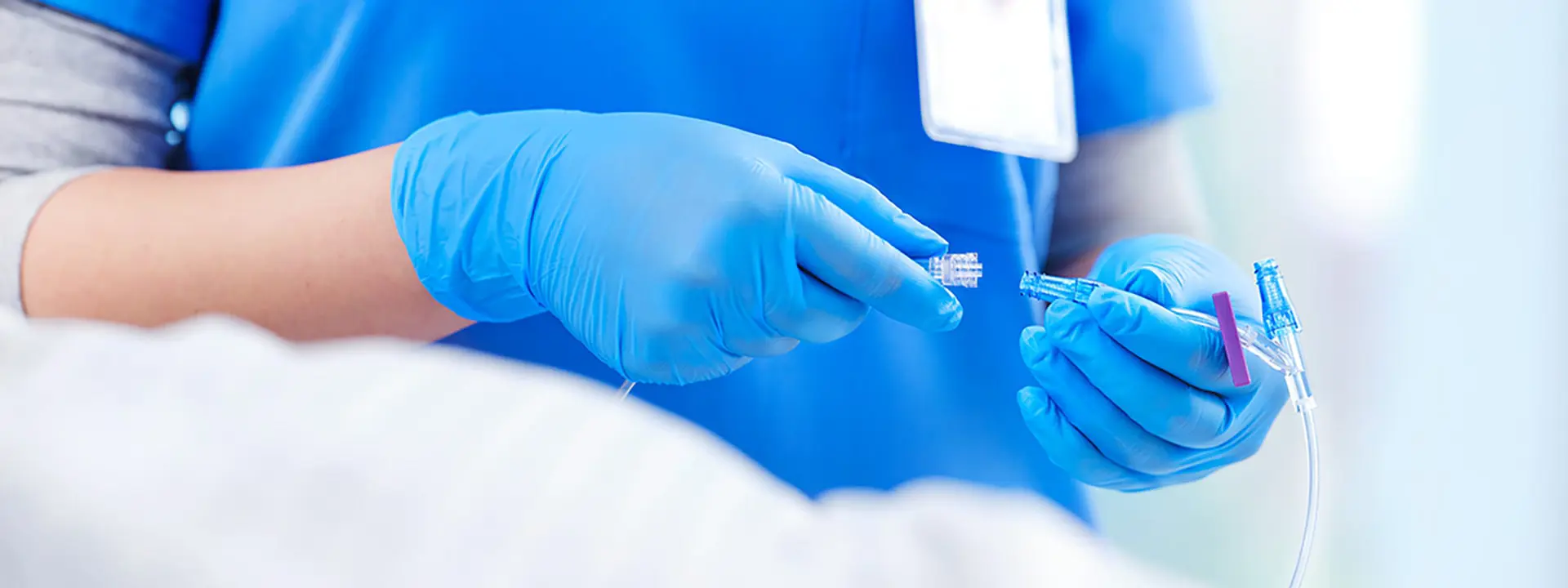IV Consumables FAQ
Prior to access, disinfect all needlefree ports using an aggressive circular motion for three (3) seconds. Disinfect with a 70% alcohol swabbing procedure.
Flush the Clave connectors with normal saline or in accordance with facility protocol. After blood use, the Clave connectors can be flushed clean and do not require change-out. Use routine flushing following facility protocol to maintain catheter patency. Change Clave connectors per facility protocol and CDC Guidelines.
This device should be changed in accordance with current, recognized guidelines of IV therapy. Clave connectors were shown to prevent microbial ingress over a 7-day period in an in-virto study.
Clave connectors may be used on any vascular access device with an ISO-standard male connection, including any power injectable catheters, tunneled catheters, and implantable ports on a Huber extension set. This also includes valved catheters, as the function of the Clave connectors does not interfere with the catheter valve.
Clave connectors may be incompatible with some male-luer connectors, including prefilled glass syringes. To avoid damage and/or delays, users should confirm mating luers or syringes have an internal diameter range of 0.062” to 0.110”. Check the internal diameter of the mating syringe or luer prior to using it to access Clave connectors. Products outside of these dimensional tolerances should not be used.
Neutral displacement Clave connectors are designed to minimize blood reflux during connection and disconnection of a luer, and will function within any clamping protocol—either before or after the male luer is disconnected from the connector. It is therefore recommended by ICU Medical to utilize protocols that have already been validated within the facility.
Clave connectors are FDA-cleared {510(k)100576} as standalone devices and, in connection with pressure-rated tubing sets, for use in power injector procedures. The devices will tolerate a peak pressure of 400 psig at a flow rate up to 10 mL/sec of room temperature contrast media.
For Clave Neutron connectors, power infusion procedures should not exceed 350 psig or 10 mL per second of contrast media.
High-pressure tubing sets or removable extension sets made with high-pressure tubing are noted in the name/description of the product.
Clave connectors are comprised of medical grade plastics and silicone, which are fully compatible with the MRI procedure.
Hold the filter vertically with the flow arrow pointed up. Keep the filter inverted until completely primed. Once the filter is primed it will eliminate air in any position
CAUTION: A filter that clogs during an infusion should be replaced. Attempting to clear the filter with pressure may lead to breakage.
Orient filter with the inlet directly above the outlet. To prime, hold the pointed end of the filter up until fully primed. The filter will automatically prime in a vertical position.
CAUTION: A filter that clogs during an infusion should be replaced. Attempting to clear the filter with pressure may lead to breakage.
Easydrop flow regulator is provided in the OPEN position to verify fluid is passing through. To verify that fluid has stopped, turn Easydrop flow regulator to the OFF position. DO NOT use Easydrop flow regulator in the OPEN position as this will cause an uncontrolled delivery (~3 liters/hr).
Use of a 15-micron filter on the administration set is suggested to prevent crystals from blocking the Easydrop flow regulator. Blood, emulsions, or medications that are not completely soluble in the carrier solution cannot be administered through the Easydrop flow regulator.
Dial numbers are approximate. Drop counting is necessary to confirm proper flow rate. High viscosity solutions can cause lower flow rates than indicated on the scale; increase head height to compensate.
To change the flow rate, adjust the height of the solution container. Raise the container to increase flow rate; lower the container to decrease flow rate. To stop flow, close the clamp and turn Easydrop flow regulator to OFF position.
Attach empty syringe to connector at dual check valve. Draw back on syringe until connector and dual check valve are sufficiently primed and adequate fluid is obtained in the syringe to prime medication line. Push fluid from the syringe at the dual check valve to prime medication line.
Close the clamp below the burette. Ensure air inlet is open. Fill burette with approximately 30 mL fluid.
Use the roller clamp to adjust the flow rate.
Yes. To add fluid or medications to the burette, close roller clamp and ensure burette airway inlet port is open. Add medication through the burette valve port. Mix thoroughly.
Invert the set and fill pump chamber completely.
For pressure/bolus infusions, open the clamp fully. Alternatively, squeeze and release pump chamber, allowing it to fill completely between push actions. Discontinue pumping when the container is empty and close the clamp.
Product inquiry
Please enter your details into the following form.









